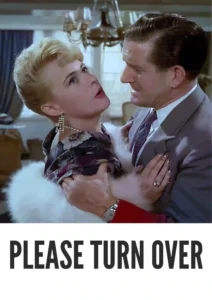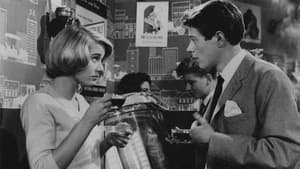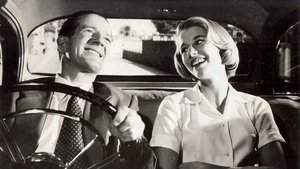Contact: info@alwanfilm.com
Video Sources 0 Views

Please Turn Over 1959 Colorized
Synopsis
Please Turn Over 1959 Colorized Review: A British Comedy Classic

Introduction
When considering the great British comedies of the 1950s, Please Turn Over (1959) stands out as a quintessential example of the era’s wit and charm. Directed by Gerald Thomas, the film provides a satirical look at suburban life in post-war Britain, revealing hidden desires and fantasies beneath the veneer of everyday respectability. With its clever script, delightful performances, and humorous take on social norms, Please Turn Over has earned its place in British cinematic history. In this review, we will explore the film’s themes, its performances, and how its satirical style still resonates today, alongside a look at its colorized version, which offers a fresh viewing experience for modern audiences.
Check The Full Colorized Movies List
Check Our Colorized Movies Trailer Channel
Understanding Please Turn Over 1959 Colorized: Director, Cast, and Genre
Director’s Vision
Gerald Thomas, best known for his work on the Carry On series, was a master of British comedy. His direction of Please Turn Over demonstrated his ability to balance farcical situations with genuine character development. Thomas had an astute understanding of British society’s quirks, and in Please Turn Over, he uses satire to expose the contradictions of post-war suburban life. His direction is fast-paced yet never rushed, allowing the humor to flow naturally from the characters and their absurd situations.
The Cast
The ensemble cast of Please Turn Over is one of the film’s greatest assets. Jean Kent, Leslie Phillips, and Ted Ray lead the cast with performances that are pitch-perfect in their comedic timing and delivery. Jean Kent, in particular, shines as the respectable but secretly yearning mother, Mrs. Halliday, whose character undergoes a hilarious transformation when her daughter’s scandalous novel begins to reveal too much about her private life.
Leslie Phillips, with his trademark suave charm, plays the role of Dr. Manners, a respectable and somewhat pompous figure who becomes entangled in the chaos. Ted Ray, as George Halliday, the bewildered and increasingly frantic father, brings a wonderful deadpan humor to the film. Together, the cast forms a cohesive unit, each playing off the others with impeccable comedic timing.
The Genre: British Satire and Farce
Please Turn Over is a brilliant example of British farce—a genre known for its exaggerated situations, misunderstandings, and rapid pacing. The film also incorporates elements of satire, particularly in its portrayal of suburban life and middle-class pretensions. At its core, the film is a comedy of manners, poking fun at the rigid social norms that dominated British society in the 1950s. The film’s humor arises from the tension between public respectability and private desires, a theme that resonates across many British comedies of the era.
Exploring the World of Please Turn Over 1959 Colorized: Plot and Characters
Detailed Synopsis
The plot of Please Turn Over revolves around a seemingly ordinary suburban family whose lives are turned upside down when the teenage daughter, Jo Halliday (played by Julia Lockwood), writes a novel that is clearly based on her family. The novel, however, portrays them in ways that are far from flattering, with thinly veiled depictions of her parents’ suppressed desires and secret lives. As the novel becomes a bestseller, the family members’ private selves are exposed to public scrutiny, leading to a series of misunderstandings, embarrassments, and comedic situations.
Mrs. Halliday, Jo’s mother, is shown in the novel as a repressed woman with romantic longings, while her father, George, is depicted as a bumbling fool. Jo’s book also suggests scandalous affairs involving the family doctor, Dr. Manners. As the line between fiction and reality blurs, the Halliday family must confront the absurd caricatures that the public now believes are their true personalities. This leads to uproarious consequences as they try to salvage their reputations while denying the accuracy of Jo’s portrayals.
Characters and Their Arcs
The characters in Please Turn Over undergo significant transformations throughout the film. Mrs. Halliday, played by Jean Kent, starts as the archetypal suburban housewife, concerned with appearances and propriety. However, as the novel forces her to confront her own desires, she begins to rebel against her previously buttoned-up existence, leading to hilarious and unexpected moments of personal discovery.
George Halliday, played by Ted Ray, is the quintessential British father: dignified, reserved, and completely out of his depth when faced with his daughter’s scandalous portrayals of him. His gradual unraveling, as he attempts to maintain his dignity in the face of growing public ridicule, provides some of the film’s funniest moments.
Dr. Manners, played by Leslie Phillips, is a pompous figure who is equally shocked and flustered by his portrayal in Jo’s book. His attempts to navigate the chaos without losing face add another layer of farce to the unfolding drama.
The Art of Film Colorization
Understanding the Process of Colorization
Film colorization, particularly in the context of classic black-and-white films, involves adding color to each frame through digital or manual techniques. Originally, Please Turn Over was shot in black and white, but a colorized version has since been released to appeal to modern audiences who might be more accustomed to watching films in color.
The colorization process for Please Turn Over was handled with great care to ensure that the added hues complemented the film’s mid-century aesthetic. By adding color, the creators aimed to enhance the visual appeal of the film without detracting from its original charm.
Development of Colorization
While early attempts at colorizing films were often rudimentary, relying on hand-tinted frames, modern technology allows for much greater precision. Today, colorization can accurately reproduce skin tones, period-appropriate clothing colors, and even subtle shifts in lighting. The colorized version of Please Turn Over reflects this technological advancement, giving the film a fresh look while preserving the essence of its original cinematography.
Early Colored Films: A Brief History
The Birth of Color in Cinema
The journey toward color in cinema began in the early 20th century, with films like The Wizard of Oz (1939) and Gone with the Wind (1939) showcasing the potential of color in storytelling. However, it wasn’t until the 1950s that color became more commonplace in filmmaking, thanks to the advent of Technicolor. Although Please Turn Over was initially filmed in black and white, its eventual colorization connects it to this rich history of early color cinema.
Please Turn Over and Its Early Colored Version
The Decision to Colorize
The decision to release Please Turn Over in a colorized format was driven by the desire to make the film more accessible to modern viewers. In an age where audiences are accustomed to vibrant color films, offering a colorized version of this British classic helps it reach a new generation of fans. The colorized version allows viewers to experience the film’s sets, costumes, and atmosphere in a fresh way while still retaining the comedic heart of the original.
Impact on the Visual Narrative
The colorization of Please Turn Over brings out the subtle details of 1950s British suburbia, from the pastel tones of suburban houses to the period-appropriate clothing worn by the characters. The added color enhances the visual appeal without distracting from the film’s humorous and satirical core. For many viewers, the colorized version breathes new life into the film, making the setting feel more immediate and relatable.
The Debate Over Film Colorization
Controversy Surrounding Colorization
As with many classic films, the colorization of Please Turn Over has sparked debate among film purists. Some argue that colorization can alter the original artistic intent of the film, which was designed to be experienced in black and white. They contend that black and white cinematography has its own unique aesthetic qualities, particularly in the way it emphasizes contrast and texture.
On the other hand, proponents of colorization argue that it can make older films more appealing to younger audiences who may be less inclined to watch black and white movies. By updating the visual presentation, colorization can introduce classic films to new viewers while preserving the essence of the original performances and story.
Examining Please Turn Over as an Early Colored Film
Does Colorization Enhance or Detract?
The colorization of Please Turn Over undoubtedly adds a new layer of visual enjoyment to the film. For viewers who appreciate the vibrant hues of 1950s design, the colorized version brings out the period’s distinct aesthetic, from the floral wallpaper to the brightly colored outfits. The question of whether colorization enhances or detracts ultimately depends on the viewer’s preference. For those who cherish the nostalgic charm of black-and-white cinema, the original version retains its timeless appeal. However, for others, the added color helps immerse them more fully in the world of the film.
Influence and Legacy: Please Turn Over 1959 Colorized’s Impact on British Cinema
A Template for Future British Comedies
Please Turn Over helped solidify the British farce as a popular genre, influencing future filmmakers and contributing to the success of subsequent films in the 1960s and 1970s. Its blend of satire and farce became a staple in British comedic cinema, paving the way for films like The Pink Panther series and later British comedies that continued to explore themes of respectability and hidden desires.
Director’s Cinematic Legacy: Beyond Please Turn Over 1959 Colorized
Gerald Thomas’ Influence
Gerald Thomas’ career went far beyond Please Turn Over. As the director of the long-running Carry On series, Thomas became synonymous with British comedy. His ability to craft hilarious yet relatable stories about ordinary people set the standard for British farce and influenced future generations of filmmakers.
Themes Explored in Please Turn Over 1959 Colorized
Honor, Respectability, and Hidden Desires
At its core, Please Turn Over is a film about the tension between public respectability and private desires. The film explores how individuals present a socially acceptable version of themselves while harboring secret fantasies or longings. This theme is particularly relevant in the context of post-war Britain, where traditional values were being challenged by the changing social landscape.
Reception and Controversy Surrounding Please Turn Over 1959 Colorized
Critical Reception
Upon its release, Please Turn Over was met with positive reviews from both critics and audiences. The film’s sharp satire, clever writing, and standout performances were praised, cementing its status as a beloved British comedy. The subsequent colorized version has been more divisive, with some praising the vibrant visuals, while others argue that the original black-and-white version remains the superior experience.
Where to Watch Please Turn Over 1959 Colorized Online
For those interested in watching Please Turn Over (1959), both the original black-and-white version and the colorized edition are available on streaming platforms like Amazon Prime Video and the British Film Institute’s online archive. DVD and Blu-ray editions, including both versions, can also be purchased.
FAQs About Please Turn Over 1959 Colorized
Q: Who stars in Please Turn Over (1959)?
A: The film stars Jean Kent, Leslie Phillips, Ted Ray, and Julia Lockwood.
Q: Is the colorized version worth watching?
A: For modern audiences, the colorized version offers a fresh perspective on the film, but fans of classic cinema may prefer the original black-and-white version.
Q: What is the film about?
A: Please Turn Over is a comedy about a suburban family whose lives are thrown into chaos when their teenage daughter writes a scandalous novel based on their lives.
Conclusion
Please Turn Over (1959) remains a brilliant example of British farce, blending satire and comedy to poke fun at suburban respectability. With stellar performances and sharp direction from Gerald Thomas, the film has earned its place as a British comedy classic. The colorized version offers a new way to experience this gem, but whether in black-and-white or color, Please Turn Over continues to entertain and provoke laughter, proving that its humor is as relevant today as it was over sixty years ago.











